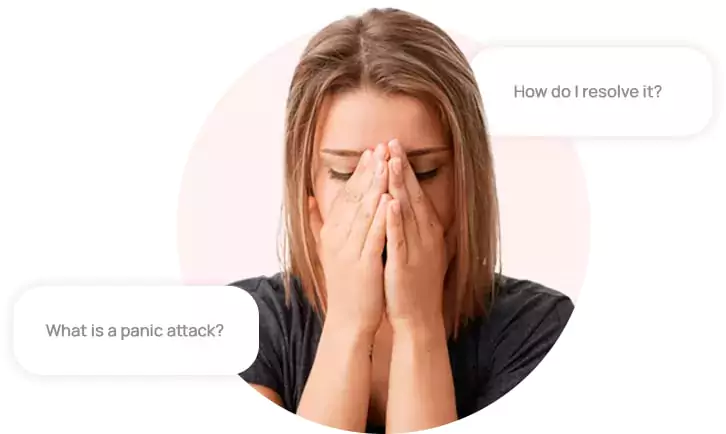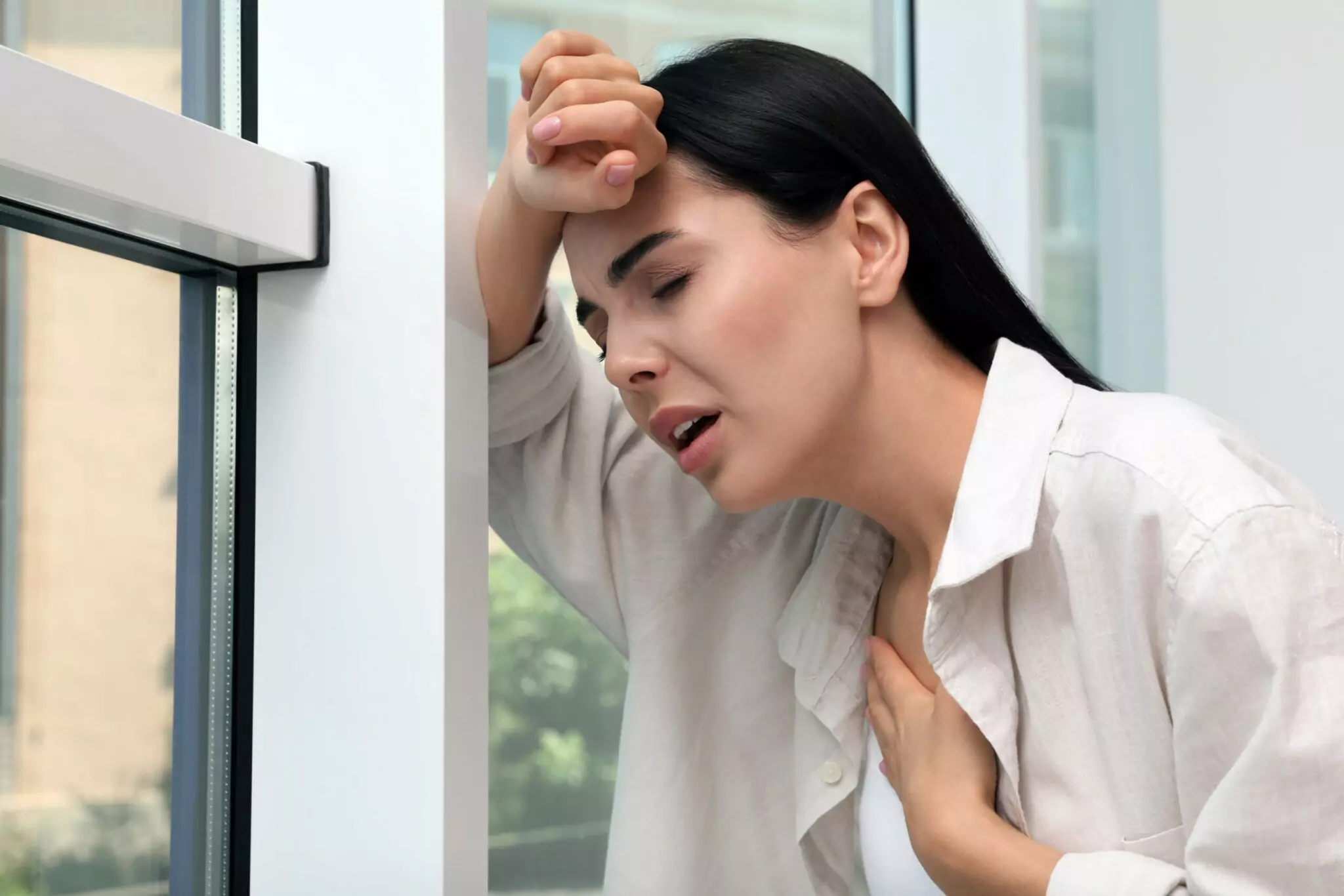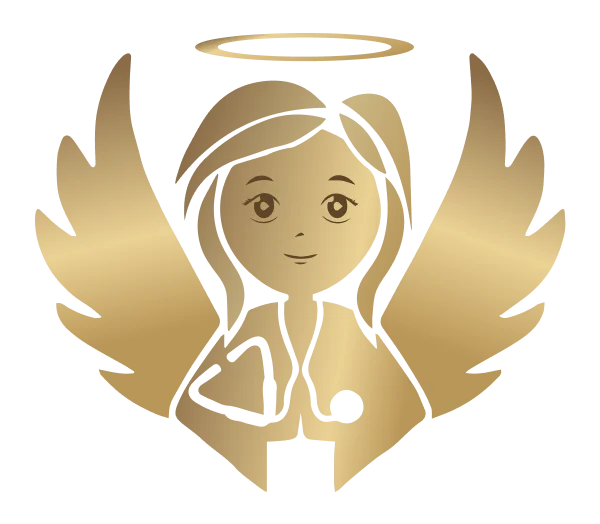

What is a Panic Attack?
Note:
11 of the 13 diagnostic symptoms are physical (e.g., palpitations, sweating) and 2 are cognitive (i.e., going crazy, fear of dying).
Symptoms of a panic attack
- Palpitations, pounding heart or accelerated heart rate.
- Sweating.
- Trembling or shaking.
- Shortness of breath.
- Choking sensations.
- Chest pain or discomfort.
- Nausea or abdominal distress.
- Feeling dizzy, light-headed, or faint.
- Chills or heat sensations.
- Paresthesia (numbness or tingling sensations).
- Derealization (feeling disconnected from reality) or depersonalization (feeling detached from yourself).
- Fear of losing control or “going crazy.”
- Fear of dying.
The sudden increase or surge in fear and discomfort can occur from an anxious or calm state of mind. The time to peak intensity, which is a few minutes, should be assessed independently of any preceding anxiety. A panic attack can return to either an anxious state or a calm state and possibly peak again.
Symptoms of panic disorder include frequent and unexpected panic attacks, constant concern about having another panic attack for over one month after the panic attack and ongoing worry about the consequences of having a panic attack like losing control or having a heart attack.
Other culture-specific symptoms include tinnitus, neck soreness, headaches, uncontrollable screaming, or crying, vertigo, loss of consciousness, loss of bladder or bowel control, slurred speech, suicidal thoughts, etc.

Dr. Valeria Serban
Board Certified Psychiatrist with Multiple State Licenses MBBS (MD)
Dr. Valeria Serban is an experienced Neuropsychiatrist. She is certified by the American Board of Psychiatry and Neurology and is an expert in treating panic disorder.
Dr. Serban uses various modalities of treat and prevent panic attacks such as medication and therapy. She also reviews labs and hormone imbalance.
Dr. Serban uses non addictive medications to treat and prevent panic attacks. She also treats complications of anxiety such as insomnia and depression.
Dr. Serban is passionate about quality patient care and will help you you regain control of your life with compassionate panic attack treatment and prevention.
Medical School
Neurology Residency Training
Master of Philosophy (M.Ph.) - Neuroscience
Internal Medicine Residency
Neurology Residency
Doctor of Philosophy (Ph.D.) - Neuroscience
Clinical Neurophysiology Fellowship
Board Certification

Dr. Tony Issac
Board Certified Psychiatrist in New York & New Jersey (MD)
Dr. Tony Issac is a double board certified psychiatrist. He is board certified in Addiction Psychiatry and by the American Board of Psychiatry and Neurology.
Dr. Issac is an expert in the treatment of panic disorders. He treats patients using a combination of medication and therapy.
As well as panic disorder Dr Issac treats depression, anxiety, social phobia, OCD and other anxiety disorders.
Dr Issac has a patient, compassionate and had a non judge mental approach. He is passionate about treating psychiatric illness and helping individuals obtain symptom relief and regain control of their lives.

Dr. Gundu Reddy
Board Certified Psychiatrist with Multiple State Licenses MBBS (MD)
Dr. Gundu Reddy is a Board Certified Psychiatrist with over fifteen years of experience practicing clinical psychiatry experience. She also has ten years of experience practicing forensic psychiatry. Dr. Reddy has trained in medication management, psychodynamic psychotherapy, and cognitive behavioral therapy.
Dr. Reddy is interested in integrative psychiatry and believes multiple factors should be considered when evaluating and treating a patient. This, as per Dr. Reddy at includes genetic and developmental factors, medical illness, nutrition, hormones, and environmental and dynamic factors.
Dr. Reddy believes that it is extremely critical to understand psychodynamic conflict and the causes of symptoms while prescribing medication, family, or relationship therapy, understanding psychodynamic conflict and causes of symptoms as will help enhance the quality of care. Apart from psychodynamic training Dr Reddy also has a background in integrative psychiatry and treatment resistance.
Schedule an Appointment with one of our Online Psychiatrists.
Clinical Services: California, Florida, Illinois, New Jersey, New York, South Carolina, Tennessee

Forensic Psychiatry Services: All of the US and Canada
Two types of panic attacks
Panic attacks often occur with mental disorders (such as anxiety disorders, depressive disorders, bipolar disorders, eating disorders, obsessive-compulsive and related disorders, personality disorders, psychotic disorders,substance use disorders) as well as in some medical conditions (such as cardiac, respiratory, vestibular, gastrointestinal). However, the majority of these never meet the criteria for panic disorder.
Having more than one unexpected panic attack may be a sign of panic disorder.
There are two types of panic attacks: Trigger and Spontaneous.

Triggered panic attacks have an obvious cue or Triggered. Triggered panic attacks may be cued by external stressors, such as phobias.

Spontaneous panic attacks are those for which there is no obvious cue or trigger at the time of occurrence (e.g., when relaxing or out of sleep).
What is a
Panic Disorder?
Recurrent spontaneous full-symptom panic attacks are required for a diagnosis of panic disorder. A panic attack is an abrupt surge of intense fear or intense discomfort that reaches a peak within minutes, and during which 4 or more of the panic attack symptoms occur.
A full-symptom attack includes at least 4 symptoms. Recurrent means more than one unexpected panic attack. Unexpected refers to a panic attack for which there is no obvious cue or trigger at the time of occurrence. The attack appears to occur out of the blue, such as when the individual is relaxing or emerging from sleep (i.e., nocturnal panic attack).

Diagnostic criteria

The disturbance is not better explained by another mental disorder. The panic attacks do not occur only in response to feared social situations, like in social anxiety disorder, or in response to circumscribed phobic objects or situations, as in specific phobia, or in response to obsessions, as in obsessive-compulsive disorder, or response to reminders of traumatic events, like in posttraumatic stress disorder, or in response to separation from attachment figures, like in separation anxiety disorder.
The Diagnostic Criteria for a Panic Disorder requires:
- Recurrent unexpected panic attacks with four or more of the 13 physical and cognitive symptoms.
- At least one of the attacks to be followed by one or more months of one or both of the following:
- Persistent concern or worry about additional panic attacks and/or their consequences, such as losing control or having a heart attack
- A significant maladaptive change in behavior related to the attacks and to avoid having panic attacks, such as avoidance of exercise or unfamiliar situations.
- The disturbance is not attributable to the physiological effects of a substance such as alcohol or drug abuse or medication, or another medical condition like hyperthyroidism or cardiopulmonary disorders.
Frequently Asked Questions
What is the Difference between a Panic Attack and Panic Disorder?
A panic attack is a single episode, which can be expected or unexpected. A panic disorder is a specific disorder that comprises recurrent episodes of unexpected full-symptom panic attacks. Some individuals may have both expected and unexpected panic attacks. Therefore, the presence of expected panic attacks does not rule out the diagnosis of panic disorder.
Individuals, with a social anxiety disorder, who have panic attacks are typically concerned about the fear of negative evaluation, whereas in a panic disorder the concern is about the panic attacks themselves.
Panic attacks that occur as a symptom of other anxiety disorders are expected and therefore not diagnosed as panic disorder. In cases where panic attacks can occur in the context of any anxiety disorder as well as other mental disorders (e.g., posttraumatic stress disorder) and some medical conditions (e.g., cardiac, gastrointestinal), they are noted as a specifier (e.g., “posttraumatic stress disorder with panic attacks”).
For panic disorder, the presence of an unexpected panic attack is contained within the criteria for the disorder and so the panic attacks are not identified separately.
What is the Difference between a Panic Attack and Anxiety?
Panic attacks can be diagnosed with DSM-5 specific criteria. Anxiety attacks aren’t recognized in the DSM-5 but anxiety is defined as a common feature of psychiatric disorders. Symptoms of anxiety include worry, distress, and fear.
The main difference between a panic attack and ongoing anxiety is it’s time to peak intensity. A panic attack, which arises suddenly from either an anxious state or a calm state, reaches peak intensity within a few minutes. Panic attacks appear abruptly, are discrete, and typically have a greater severity. Anxiety gradually becomes more intense over minutes, hours, or days and can prevail for long periods. It is usually related to the anticipation of a stressful situation, experience, or event.

What happens to my body when I am having a Panic Attack?
Your body may experience sweating, trembling, shaking, feeling choked, shortness of breath, fastened heartbeat or palpitations, extreme chills or heat flashes, feeling dizzy, nausea, fatigue, weakness, confusion, inability to concentrate, lump in the throat, difficulty swallowing, muscle pains or spasms, abdominal pain, heartburn, chest pain, tingling or numbing sensations, loss of consciousness, loss or bladder or bowel control, vertigo, slurred speech, blurred vision, and other extreme physical discomforts.
When you have a panic attack, your rate, and pattern of breathing change. It becomes rapid and slow causing hyperventilation and physical discomfort. Your eyes dilate, sweat glands perspire, mouth dries, muscles tense, blood decreases in arms, blood sugar level increases, and heart rate increases. Psychologically, you may feel extreme anxiety or fear of dying or losing control (“going crazy”).

What are the Causes of Panic Attacks?
Triggers or Risks for Panic Attacks are:
- Genetic: a family history of anxiety disorders or depressive illness can lead to an increased risk for panic disorder
- Nutritional deficiencies: B12 or magnesium deficiency and unhealthy habits like smoking or excessive caffeine intake can cause higher chances of panic attacks
- Hormone imbalance: hyperthyroidism, low progesterone, imbalance of serotonin system can cause panic attacks
- Trauma and dysfunctional external environments: extremely stressful experiences, such as childhood abuse, sexual or physical abuse, being made redundant, job loss, divorce, or the death of a family member or friend
- PTSD: Individuals who have experienced trauma live in fear of that trauma happening again. PTSD-related anticipatory anxiety can occur as a symptom of any traumatic experience — a car crash, a mugging, or witnessing a loved one’s death.
- Specific phobias: such as agoraphobia or fear of being in situations when one might not be able to attempt escape.
- Negative affectivity (neuroticism): proneness to experiencing negative emotions

- Substance use such as recreational drugs, marijuana, alcohol (withdrawal).
- Medical conditions: cardiac arrhythmias, asthma, chronic obstructive pulmonary disease, and irritable bowel syndrome are also associated with panic disorder.
- Thyroid disease, asthma, and pheochromocytomaare also causes of panic attack.
- Idiopathic the cause is unknown.

Who can get a Panic Attack?
Anyone.
Symptoms of panic disorder often start in the late teens or early adulthood and affect more women than men.
Older adults tend to attribute their panic attacks to certain stressful situations, such as a medical procedure or social setting. With situational explanations for the panic attack, they preclude the diagnosis of panic disorder, even if an attack might have been unexpected at the moment. This can result in under-endorsement of unexpected panic attacks and panic disorder in older individuals.
Panic disorder is more common in individuals with other anxiety disorders like agoraphobia, depression, and bipolar disorder. Comorbidity with other anxiety disorders and illness anxiety disorder is common. Panic disorder is also significantly comorbid with numerous general medical symptoms and conditions, including, but not limited to, dizziness, cardiac arrhythmias, hyperthyroidism, asthma, COPD, and irritable bowel syndrome.
Does everyone who has Panic Attacks also have Agoraphobia?
- In an enclosed space – theatre, meeting room, or small shop
- In an open space – bridge, car park, or large shopping mall
- On public transport – bus, train or plane
- Out of your home alone.
“Agoraphobia can be diagnosed irrespective of the presence of panic disorder. However, not everyone who has panic disorder is diagnosed with agoraphobia.”
When criteria for panic disorder are met, agoraphobia should not be diagnosed if the avoidance behaviors associated with the panic attacks do not extend to avoidance of two or more agoraphobic situations. If the patient’s condition meets the criteria for panic disorder and agoraphobia, both diagnoses are assigned.

“Agoraphobia can be diagnosed irrespective of the presence of panic disorder. However, not everyone who has panic disorder is diagnosed with agoraphobia.”
When criteria for panic disorder are met, agoraphobia should not be diagnosed if the avoidance behaviors associated with the panic attacks do not extend to avoidance of two or more agoraphobic situations. If the patient’s condition meets the criteria for panic disorder and agoraphobia, both diagnoses are assigned.

Can people who get Panic Attacks get PTSD?
Yes. Almost one-third of individuals with panic disorder screen positive for panic-attack-related post-traumatic stress disorder.
Individuals with pre-existing anxiety disorders are at greater risk than others for developing post-traumatic stress disorder (PTSD).
The panic disorder itself may cause PTSD from panic attacks as patients get anxiety about the panic attacks themselves. Severe symptoms of a panic attack such as difficulty concentrating, trouble managing emotions and moods, restlessness, loss of consciousness, nausea, sleep deprivation, feeling of losing control or “going crazy”, frustration and hopelessness can result in post-traumatic stress disorder (PTSD) and anticipatory anxiety from panic attacks.
“The Fear of having a Panic Attack is more Disabling than having a Panic Attack itself.” How to Treat Anticipatory Anxiety?
Anticipatory anxiety is the fear and worry that something bad may happen. With anticipatory anxiety, patients tend to spend a lot of time imagining worst-case scenarios and over-focusing on unwanted outcomes and on things they can’t control or predict.
Anticipatory anxiety isn’t a disorder but rather a symptom. For panic disorder treatment:


How do Panic Attacks affect my Life?
Panic attacks and panic disorder can lower your quality of life and drastically affect your social life, professional ability, and physical well-being as well as incur considerable economic costs.
The anxiety and fear associated with panic attacks can lead to additional mental health disorders (e.g., depression), substance abuse, fears, avoiding duties, social isolation, and problems at school or work. Individuals with panic disorder may be frequently absent from work or school for doctor and emergency room visits. This may lead to unemployment or dropping out of school. Panic attacks can impair caregiving duties in older adults/ parents. Anticipatory anxiety related to panic attacks can become so severe that you avoid certain situations, which could strain your relationships with friends and family.
Panic attacks and anxiety worsen, if left untreated, and are related to a higher rate of suicide attempts and suicidal thoughts (especially in cases with a history of childhood abuse).
How to Diagnose Panic Disorder?
A complete examination by a medical practitioner is required to diagnose panic disorder. This includes a physical exam, blood tests to check thyroid and other possible conditions, ECG or EKG tests on your heart, and a psychological evaluation to discuss your symptoms, fears or concerns, stressful situations, relationship problems, and family history.
Panic disorder is not diagnosed if panic attacks are a direct physiological consequence of another medical condition. Medical conditions such as hyperthyroidism, hyperparathyroidism, pheochromocytoma, vestibular dysfunctions, seizure disorders, and cardiopulmonary conditions (e.g., arrhythmias, supraventricular tachycardia, asthma) can cause panic attacks. Appropriate laboratory tests or physical examinations help determine the etiological role of another medical condition.

Panic disorder is not diagnosed if panic attacks are a direct physiological consequence of a substance. Intoxication with substances or stimulants such as cocaine, caffeine. or cannabis and withdrawal from central nervous system depressants (e.g., alcohol, barbiturates) can trigger a panic attack. However, if panic attacks continue to occur outside of the context of substance use (e.g., long after the effects of intoxication or withdrawal), a diagnosis of panic disorder should be considered.
Panic attacks that occur as a symptom of other mental or anxiety disorders are expected (e.g., triggered by social situations in social anxiety disorder, by phobic objects or situations in specific phobia or agoraphobia, by worry in generalized anxiety disorder, by separation from home or attachment figures in separation anxiety disorder) and therefore do not meet criteria for panic disorder. Only if the individual experiences unexpected panic attacks and shows persistent worry or behavioral change because of the attacks, then an additional diagnosis of panic disorder along with the other anxiety disorder should be considered before proceeding with panic disorder treatment.
Can certain Medications cause Panic Attacks?
Yes, certain medications such as albuterol (asthma inhalers), certain antacids, certain psychiatric medications can trigger panic attacks.


How does this attack affect my Life?
Often patients use marijuana or alcohol to cope with panic attacks, anxiety, and other social anxiety disorders. While alcohol and small doses of marijuana can lessen or reduce anxious thoughts that tend to lead to panic attacks, the use of alcohol and marijuana is only a temporary fix. It stops working once the substance and its effects leave the body. Continuous use of alcohol and marijuana to cope with panic attacks can cause long-term damaging problems.
Some individuals with panic disorder may develop a substance-related disorder, which has resulted from an attempt to treat their anxiety with alcohol or medications.
Note: Smoking is also a triggering risk factor for panic attacks and panic disorder.
Is Panic Attack Treatment possible?
Yes. Panic attacks are treatable and anyone suffering from panic attacks should seek treatment and avoid suffering from panic attacks unnecessarily.


Is Panic Disorder treatment successful?
Yes, panic disorder treatment can reduce the intensity and frequency of panic attacks and help improve everyday life. If you have panic attacks but not a diagnosed panic disorder, you can still benefit from treatment.
If panic attacks aren’t treated, they can get worse and develop into panic disorder or phobias. If you are suffering from panic attacks, it is recommended to get professional help.
What is the treatment for Panic Attacks?
There are two main types of treatments for panic disorder and/or panic attacks: psychotherapy and medication. One or both types of treatment may be recommended, depending on your preference, your history, the severity of your panic disorder, etc.
Psychotherapy or talk therapy is an effective first-choice treatment for panic disorder.
A form of psychotherapy called cognitive behavior therapy (CBT) can help you understand panic attacks and what triggers your symptoms, learn how to cope with them and how to change unwanted behavior.
Successful psychotherapy treatment can also assist you in overcoming fears of situations that you have avoided because of panic attacks.
Medication treatment for panic disorder can include either antidepressant or anti-anxiety medication.
Medications can help reduce symptoms associated with panic attacks.
References:
https://www.ncbi.nlm.nih.gov/pmc/articles/PMC6354045/
https://www.ncbi.nlm.nih.gov/pmc/articles/PMC1444835/
https://pubmed.ncbi.nlm.nih.gov/28613692/


What are some self-help ways to deal with this disorder?
Some ways you can support your mental wellbeing include:
- Sticking to your treatment plan.
- Eating a healthy diet. Avoid caffeine, alcohol, smoking, and recreational drugs – all of which can trigger or worsen panic attacks.
- Exercising. Physical activity can have a calming effect on your mood.
- Getting sufficient sleep and joining a support group or seeking out online forums to connect you with others facing similar problems.
- Training in relaxation and stress management techniques. Yoga, deep breathing, and progressive muscle relaxation can be helpful.
- Staying connected with family and friends and reaching out for help in an emergency
How much does it cost to see an online psychiatrist at Gaba Telepsychiatry?
Your first online appointment with one of our psychiatrists will cost $400. The follow-up appointments will be $250. If you have out-of-network benefits, we can submit claims on your behalf.



